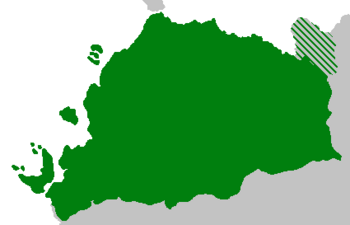Oscaunja
This article is incomplete because it is pending further input from participants, or it is a work-in-progress by one author. Please comment on this article's talk page to share your input, comments and questions. Note: To contribute to this article, you may need to seek help from the author(s) of this page. |
Kingdom of Oscaunja Rraigno do Oscaunja | |
|---|---|
| Motto: Paies do Juorno (Country of Day) | |
| Anthem: Fronni d'Alia "Daughter of Alia" | |
 | |
| Capital | Kastomarre |
| Largest city | Kassano |
| Official languages | Linj'Arrendino |
| Recognized languages | Linj' Imazinga |
| Ethnic groups | Arrendini- 40.5% Imazzingi- 28.25% Rriguani- 21.75% Aulerriano- 6.5% Suddani 2.9% Other 0.1% |
| Demonym(s) | Oscaundano |
| Government | Constitutional Monarchy |
• Rrai | Reney IV Raissuolli |
• Vocadir | Gian di Verdecoye |
| History | |
• Three Kingdom Period | 653-1043 AD |
• Unification of Oscaunja | 1044 AD |
• Respoblija do Oscaunja | 1791-1792 AD |
• Kingdom of Oscaunja | 1792-1858 AD |
• Republique de Civivaté et Allié | 1858-1904 AD (annexed by the Auvernian Federation) |
• Kingdom Restored | 1919 AD |
• Independence Regained | 1927 AD |
| Area | |
• | 1,365,312 km2 (527,150 sq mi) |
| Population | |
• 1936 estimate | 11,000,000 |
| GDP (PPP) | estimate |
• Total | 14.8 Billion Dollars |
| Currency | Oscaundano Duocado |
| Driving side | right |
The Kingdom of Oscaunja (Arrendino: Rraigno do Oscaunja; Alpanian: Regnum Auschonia), is a constitutional kingdom on the Northwestern coast of Nymera in the world of Verthandi. Founded in 1044 A.D. by Guillamo I the Unifier, Oscaunja remained an independent power for most of its history, until its annexation by the Auvernian Federation in 1904. Independence was regained following the deposition of Rrai Reney III and a short but bloody civil war in 1927.
Etymology
History
The history of Oscaunja begins with the colonization of Northwestern Nymeria by the Alpanian Republic in ___ AE. Client kingdoms were formed in the south and west by Imazzingi chieftains who had obtained Alpanian recognition, eventually leading to the formation of the Kingdoms of Kabarlad and Tafrwa. In reality little more than tribal confederacies, the Imazzingi avoided incorporation into the Holy Aventine Empire through the Concordat of Casinum, which expanded Imperial rule westward and established the city of Casinum (modern-day Kassano) as a trade and military outpost on the Hibernian Sea.
Three Kingdoms Period: 653-1044 A.D.
Unification: 1044 A.D.
Interregnum and House of Kastomarre
Second Interregnum and the Hundred Year War: 1315-1415
The Three Ferrannos
House of Kastomarre-Beyprato
Respoblija do Oscaunja: 1791-1792
House of Raissuolli-Beyprato
Republique de Civivaté et Allié
Annexation and the Civil War
Restoration of the Monarchy
Independence War and Present Day
Geography
Politics
Government
The government of the Kingdom of Oscaunja, as defined by the Constitution of 1919 and later reconfirmed in the amended Constitution of 1927, consists of a hereditary Monarch, the Rrai, as executive, with the right to propose and veto laws, a final Court of Appeal, O'Assedir, which enforces Royal decrees, and the legislature, the Concialle Rraile (Royal Council), which is organized corporately with members who are both hereditary and appointed. The head of the Concialle is the Vocadir (Chief Advocate).
Local government is carried out by officials who receive the non-hereditary noble title Sijore, while provincial governors are entitled Barune. The noble title Conde is non-political yet retains immense prestige and almost all Condi are members of the Concialle Rraile. The title Dujo is reserved for members of the royal family, while Prinje is used by the descendants of the original Hartmanni clans.
Political Parties and Elections
The Concialle Rraile is broadly controlled by several factions, most notably the Leggemandi (Legitimists), the Pardo Respoblijano Nazionali (National Commonwealth Party), and the Lianzia Merkandi (Merchants Alliance).
Foreign Relations and Military
The Esergido Rraile (Royal Army) is composed of 44,000 soldiers, 450 officers, and 20,000 tribal irregulars (of dubious loyalty). Apart from the Uardi Rraile (Royal Guardsmen), the regular army is divided between 13 Infantry Regiments, 4 Cavalry Regiments, 3 Artillery Regiments, and a small Mechanized Infranty Brigade. Special divisions are devoted to scouting and a Brigade of Kagiadori (Mountaineers) and Ustadori (Sappers) form the core of the Special Forces.
The core of the Esergido, especially the Kagiadori, is well trained, as most infantry and cavalrymen are veterans of the 1919 Civil War and the Independence War in 1927. The artillery regiments are newly organized and under-trained, as are most irregulars.
Demographics
Ethnic Groups
Languages
| Linj'Arrendino | English |
|---|---|
| Kredo ‘n Diou Patrem monipotande, Kritour ciele a dera, ki se voette tout a noi se voete, a in domne Gesún Kriston, Filjou Dio ‘n suole ki Diou per sa neiste avuoni de tout deluaos, Diou do Dio, klara do klare, Diou veritade do Dio veritadem, naisete noi faiste, d’uon re Patrorem. | I believe in God the Father Almighty, Creator of heaven and earth, that which is seen by all and that which is not seen, and in the Lord Jesus Christ, Son of God, alone from God begotten before all ages, God from God, Light from Light, True God from God, begotten not made, of one substance with the Father. |
Religion
Healthcare
Education
Economy
The economy of Oscaunja is largely argicultural, although a burgeoning industrial sector centered around copper and silver mining in the Adraro Mountains is recovering from the effects of the 1927 Civil War. Trade is conducted with Auvernia and Imperial Nymera. Foreign investors (almost entirely from the Auvernian Federation) hold stakes in all major industries. It is common for large areas of agricultural land to be owned corporately by clans, worked by tenant farmers, and several port cities (including the second largest port Civitade) are controlled by merchantile monopolies.



